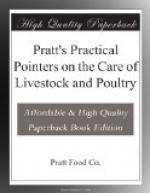(4) Ground peas and oats, also fed in equal proportions. The succotash mixture may be fed alone or in conjunction with other meal added to make the food still more in balance.
It is preferable to feed meal admixed with cut fodders. The mastication that follows will then be more thorough and the digestion more complete. When ensilage is fed, admixture will result sufficiently if the meal is thrown over the ensilage where it has been put into the mangers.
In order to insure the animal obtaining full benefit of all its feed, it will be found highly profitable to include Pratts Cow Remedy with the daily ration. It acts as a digestive and at the same time insures a healthy and natural action of the bowels.
Bulls should be fed and managed with a view to secure good, large and robust physical development and the retention of begetting powers unimpaired to a good old age. The aim should be to avoid tying bulls in the stall continuously for any prolonged period, but to give them opportunity to take exercise in box stalls, paddocks, and pastures to the greatest extent that may be practicable.
-------------------------------------------------------
---------- Jacksonville, Fla.
Have used Pratts Cow Remedy with good success as a general tonic and for increasing milk. Omitting it at intervals as a test showed a falling off of about a pint for each cow, which was always made up when the remedy was added.
T.C. JOHNSTON. ------------------------------------------------------------
-----
A ring should be inserted in the nose when not yet one year old. Rings most commonly used are two and one-half to three inches in diameter. When inserting them the head of the animal should be drawn tightly up to a post or other firm objects, so that the muzzle points upward at a suitable angle. A hole is then made with a suitable implement through the cartilage between the nasal passages, and forward rather than backward in the cartilage. The ring is then inserted, the two parts are brought together again, and they are held in place by a small screw. When ringed, a strap or rope with a spring attached will suffice for a time when leading them, but later they should be led with a lead, which is a strong, tough circular piece of wood, four to five feet long, with a snap attached to one end.
[Illustration: PRATTS PRACTICAL POINTERS]




